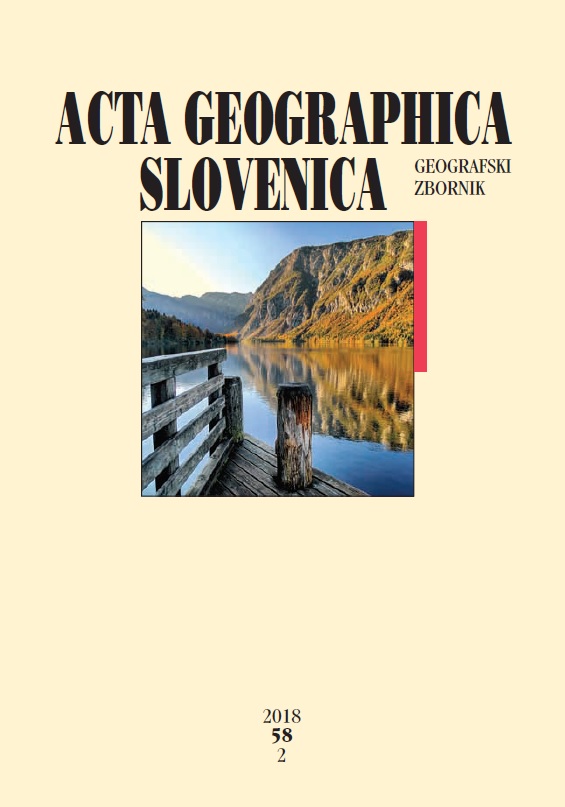Eastern European cities as command and control centres in a time of economic crisis
DOI:
https://doi.org/10.3986/AGS.3124Keywords:
economic geography, corporation, headquarters, command and control function, Deloitte, Eastern EuropeAbstract
This article describes the command and control function of eastern European cities based on the financial performance of the largest corporations with headquarters in the region and the impact of selected sectors on this function. Research has shown that, despite the global economic crisis of 2008–2012, the revenue and net income of the companies studied have increased to some extent. Currently, the strongest “command and control cities” in eastern Europe are Warsaw and Prague. The sector that exerts the greatest influence on the regional command and control function in eastern Europe is the consumer business and transportation sector. The economic crisis has also produced a geographical pattern in eastern Europe that runs counter to current global trends: companies in the region currently tend to concentrate their headquarters in fewer cities, which is becoming common in other parts of the world. The article employs a standardization method based on the mean and standard deviation of financial values for each corporation studied.Downloads
References
Alderson, A. S., Beckfield, J. 2004: Power and position in the world city system. American Journal of Sociology 109-4. DOI: https://doi.org/10.1086/378930
Anttiroiko, A. V. 2015: City branding as a response to global intercity competition. Growth and Change 46-2. DOI: https://doi.org/10.1111/grow.12085
Brozzi, R. Lapuh, L., Nared, J., Streifeneder, T. 2015: Towards more resilient economies in Alpine regions. Acta geographica Slovenica 55-2. DOI: https://doi.org/10.3986/AGS.916
Csomós, G. 2012: GaWC Data Set 26: global command and control centres, 2006/2009/2012. Internet: http://www.lboro.ac.uk (15. 3. 2015).
Csomós, G. 2013: The command and control centers of the United States (2006/2012): An analysis of industry sectors influencing the position of cities. Geoforum 12-50. DOI: https://doi.org/10.1016/j.geoforum.2013.09.015.
Csomós, G. 2015: The Ranking of Cities as Centres of the Hungarian Economy, 1992-2012. Regional Statistics 1-5. DOI: https://doi.org/10.15196/RS05104
Csomós, G., Derudder, B., 2014: European cities as command and control centres, 2006-11. European Urban and Regional Studies 21-3. DOI: https://doi.org/10.1177/0969776412453149
Deloitte Central Europe Top 500 report, 2014. Internet: www.deloitte.com (15. 10. 2014).
Dorocki, S., Boguś, M. 2014: Regional variety of biotechnology development in Asia. Procedia - Social and Behavioral Sciences 120. DOI: https://doi.org/10.1016/j.sbspro.2014.02.097
Duranton, G., Puga, D. 2000: Diversity and specialisation in cities: why, where and when does it matter? Urban Studies 37-3.
Friedmann, J., Wolff, G. 1982: World city formation: an agenda for research and action (urbanization process). International Journal of Urban & Regional Research 6-3. https://doi.org/10.1111/j.1468-2427.1982.tb00384.x
Friedmann, J. 1986: The world city hypothesis. Development and Change 17-1. DOI: https://doi.org/10.1111/j.1467-7660.1986.tb00231.x
Froot, K. A. 1994: Foreign direct investment in eastern Europe: some economic considerations. Transition in Eastern Europe 2. Chicago.
Gierańczyk, W., Rachwał, T. 2012: Structural changes in the industry of Poland against the background of eastern European Union states. Quaestiones Geographicae 31-2.
Hall, P. 1966: The World Cities. London. DOI: https://doi.org/10.1080/00420989120080651
Internet 1: Gawc www.lboro.ac.uk (15. 3. 2015).
Internet 2: Forbes www.forbes.com (15. 3. 2015).
Internet 3: Deloitte www.deloitte.com (15. 3. 2015).
Jakóbczyk-Gryszkiewicz, J. 2011: Łódź u progu XX wieku. Studia Miejskie 4.
Kincses, Á., Nagy, Z., Tóth, G. 2013: The spatial structures of Europe. Acta Geographica Slovenica 53-1. DOI: https://doi.org/10.3986/AGS53103
Lorber, L. 1999: The economic transition of Slovenia in the process of globalisation. Geografski zbornik 39.
Lyons, D., Salmon, S. 1995: World cities, multinational corporations, and urban hierarchy: the case of the United States. World cities in a World-system. Cambridge.
Rachwał, T. 2011: Industrial restructuring in Poland and other European Union states in the era of economic globalization. Procedia. Social and Behavioral Sciences 19. DOI: https://doi.org/10.1016/j.sbspro.2011.05.100.
Rachwał, T., Boguś, M. 2012: The competitiveness of industrial enterprises in European Union Countries. Current problems of competitiveness improvement in national economies and enterprises..
Ravbar, M. 2009: Economic geographical assesment of investments – a development factor in regional development. Acta geographica Slovenica 49-1. DOI: https://doi.org/10.3986/AGS49105
Raźniak, P. 2014: City’s position in international rankings and quality of offered tourist service. Tourism: An International Interdisciplinary Journal 62-2.
Raźniak, P., Winiarczyk-Raźniak, A. 2015: Did the 2008 global economic crisis affect large firms in Europe? Acta Geographica Slovenica 55-1. DOI: https://doi.org/10.3986/AGS.740.
Raźniak, P., Winiarczyk-Raźniak, A., Nowotnik, D. 2015: Central and Eastern European Cities in globalized world. Socio-Economic Problems and the State 12-1.
Sassen, S. 1991: The Global City: New York, London, Tokyo. Princeton.
Sassen, S. 2006: Cities in a world economy. Thousand Oaks.
Śleszyński, P. 2007: Gospodarcze funkcje kontrolne w przestrzenie Polski. Prace Geograficzne 213.
Taylor, P. J. 2004: World city network: a global urban analysis. London.
Taylor, P. J., Csomós, G. 2012: Cities as control and command centres: Analysis and interpretation. Cities 29-6. DOI: https://doi.org/10.1016/j.cities.2011.09.005
Wójtowicz, M., Dorocki, S. 2014: Regional differences in the development of the biotechnology industry in Latin America, with particular emphasis on Brazil and Mexico. Environmental and socio-economic transformations in developing areas as the effect of globalization. Krakow.
Downloads
Published
How to Cite
Issue
Section
License
Copyright (c) 2018 Piotr Raźniak, Sławomir Dorocki, Anna Winiarczyk-Raźniak

This work is licensed under a Creative Commons Attribution-NonCommercial-NoDerivatives 4.0 International License.









